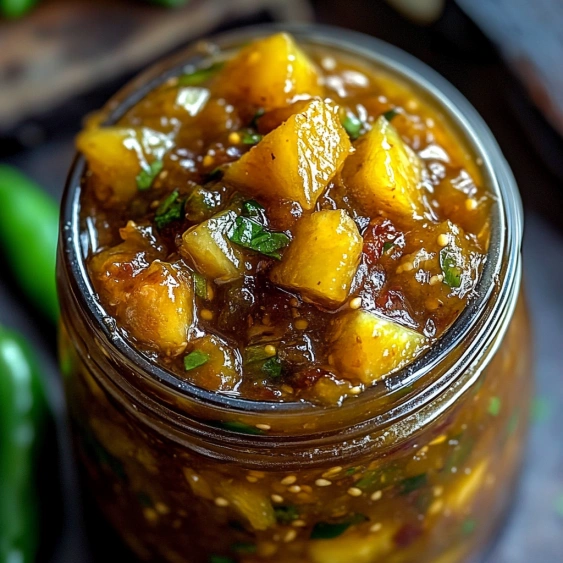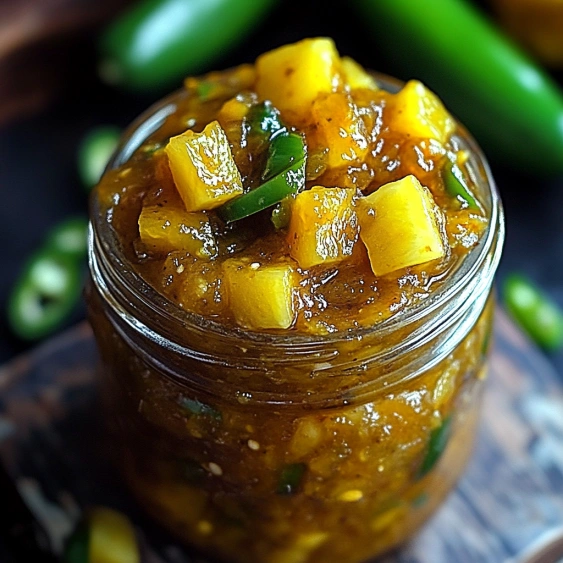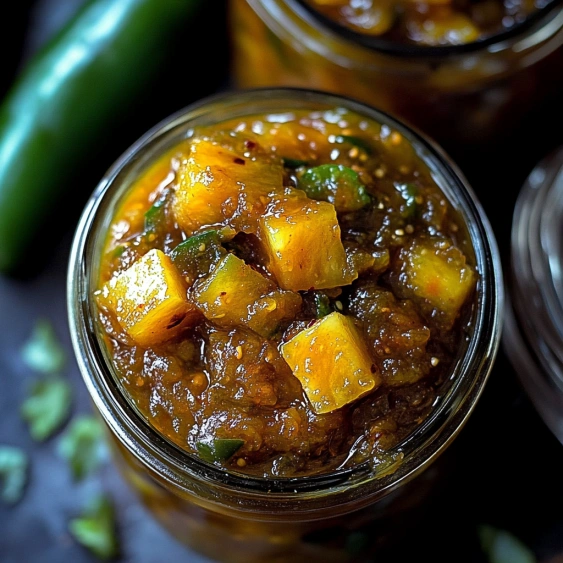 Pin it
Pin it
This spicy pineapple jalapeño chutney has become my secret weapon for transforming ordinary meals into memorable feasts. The sweet-heat combination creates a perfect balance that complements everything from grilled chicken to cheese platters.
I first made this chutney for a backyard barbecue when I wanted something different than traditional salsa. It was such a hit that guests were literally spooning it directly from the jar by the end of the night.
Ingredients
- Fresh pineapple: Delivers natural sweetness and tropical flavor that canned versions simply cannot match
- Jalapeños: Provide adjustable heat while adding beautiful green flecks throughout the chutney
- Red onion: Offers a milder flavor than yellow varieties and adds gorgeous purple color contrast
- Apple cider vinegar: Brings necessary acidity while enhancing the fruity notes
- Brown sugar: Deepens the flavor with caramel notes that regular sugar lacks
- Ground ginger: Adds warmth and complexity that complements both sweet and spicy elements
- Ground cumin: Introduces an earthy undertone that balances the fruity sweetness
- Salt and black pepper: Enhance all other flavors and provide classic seasoning
- Optional lime juice: Brightens the entire mixture with citrus notes
Step-by-Step Instructions
- Prepare the Ingredients:
- Peel and core the pineapple, then dice into small quarter inch cubes for ideal texture. Remove seeds from jalapeños before mincing finely unless you prefer extra heat. Dice the red onion into pieces similar in size to the jalapeños for even distribution throughout the chutney.
- Combine Everything:
- Add all ingredients to a medium saucepan and stir thoroughly to ensure even distribution of spices. The mixture might look somewhat dry initially, but the pineapple will release juices as it cooks.
- Simmer to Perfection:
- Bring the mixture to a gentle simmer over medium heat, then reduce to medium low. Cook for 15 to 20 minutes, stirring every few minutes to prevent sticking. You want the pineapple to soften but not completely break down, maintaining some textural integrity.
- Flavor Adjustment:
- Taste the chutney carefully before removing from heat. This is the moment to personalize it to your preference. Add more salt if flavors seem flat, a touch more brown sugar if too tart, or lime juice if you want more brightness.
- Cooling Period:
- Allow the chutney to cool in the pan for about 10 minutes before transferring to storage containers. The mixture will thicken slightly as it cools, developing a more jammy consistency.
- Storage Transfer:
- Spoon the chutney into clean glass jars while still slightly warm. For best results, use proper canning methods if planning to store long term.
 Pin it
Pin it
My absolute favorite ingredient in this recipe is the fresh pineapple. I discovered after multiple tests that using ripe but still slightly firm pineapple creates the best texture, preventing the chutney from becoming too mushy during cooking.
Make Ahead Instructions
This chutney actually improves with time as the flavors meld together. For best results, make it 24 hours before serving to allow the spices to fully integrate with the fruit. The chutney will maintain peak flavor for about 5 days, though it remains delicious for up to two weeks in the refrigerator. If you want to make larger batches, this recipe can be properly canned following standard water bath canning procedures, allowing for months of storage.
Serving Suggestions
The versatility of this chutney makes it a perfect addition to so many meals. Serve it alongside grilled pork tenderloin or chicken breasts for a tropical flavor boost. Spoon it over cream cheese with crackers for an instant appetizer that disappears quickly at gatherings. My family loves it with fish tacos where the spicy sweetness perfectly balances the mild fish and creamy slaw. For an unexpected breakfast treat, try a dollop on scrambled eggs or as a topping for avocado toast.
 Pin it
Pin it
Heat Level Customization
The beauty of making your own chutney is controlling exactly how spicy you want it. For a mild version that everyone can enjoy, remove all jalapeño seeds and membranes, using just 2 peppers. Medium heat comes from leaving some seeds in or using 3 peppers. For serious heat lovers, include all seeds from 3 jalapeños or substitute one with a hotter pepper like serrano or habanero. Remember that the heat develops over time, so what tastes mildly spicy when fresh may pack more punch the next day.
Frequently Asked Questions
- → How spicy is this pineapple jalapeño chutney?
The spice level is customizable based on your preference. Using 2 jalapeños with seeds removed provides mild heat, while 3 jalapeños or keeping some seeds will create a spicier version. You can always start with less and add more to taste during cooking.
- → How long does homemade pineapple jalapeño chutney last?
When stored in an airtight container in the refrigerator, this chutney will last for up to 2 weeks. For longer storage, you can freeze portions for up to 3 months or use proper canning techniques for shelf-stable preservation.
- → Can I use canned pineapple instead of fresh?
Yes, you can substitute canned pineapple chunks (drained) if fresh isn't available. However, fresh pineapple provides better texture and flavor. If using canned, you may need to reduce the cooking time slightly as canned pineapple is already soft.
- → What can I serve with pineapple jalapeño chutney?
This versatile chutney pairs wonderfully with grilled chicken, pork, or fish. It's excellent on cheese boards, particularly with creamy cheeses like brie or goat cheese. It also makes a delicious topping for tacos, burgers, or as a dip with tortilla chips.
- → Can I make this chutney less sweet?
Absolutely! You can reduce the brown sugar to 2-3 tablespoons if you prefer a less sweet chutney. The pineapple provides natural sweetness, so you can adjust according to taste. Adding more lime juice will also balance sweetness with acidity.
- → Is there a way to make this chutney smoother or chunkier?
For a smoother consistency, you can pulse the finished chutney briefly in a food processor. For a chunkier version, dice the pineapple in larger pieces and reduce the cooking time slightly to maintain more texture. The standard recipe produces a medium-chunky consistency.
